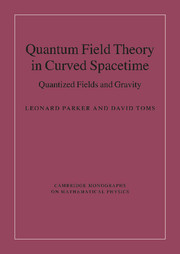Book contents
- Frontmatter
- Contents
- Preface
- Acknowledgments
- Conventions and notation
- 1 Quantum fields in Minkowski spacetime
- 2 Basics of quantum fields in curved spacetimes
- 3 Expectation values quadratic in fields
- 4 Particle creation by black holes
- 5 The one-loop effective action
- 6 The effective action: Non-gauge theories
- 7 The effective action: Gauge theories
- Appendix: Quantized Inflaton Perturbations
- References
- Index
Preface
Published online by Cambridge University Press: 25 January 2011
- Frontmatter
- Contents
- Preface
- Acknowledgments
- Conventions and notation
- 1 Quantum fields in Minkowski spacetime
- 2 Basics of quantum fields in curved spacetimes
- 3 Expectation values quadratic in fields
- 4 Particle creation by black holes
- 5 The one-loop effective action
- 6 The effective action: Non-gauge theories
- 7 The effective action: Gauge theories
- Appendix: Quantized Inflaton Perturbations
- References
- Index
Summary
The success of Einstein's theory of general relativity convincingly demonstrates that the classical gravitational field is a manifestation of the curvature of spacetime. Similarly, quantum field theory in Minkowski spacetime successfully describes the behavior of elementary particles over a wide range of energies. It has proved notoriously difficult to understand how gravity fits with the quantum attribute of the fields that transmit the other forces of nature. Leading attempts to combine gravitation and quantum field theory include string theory and loop quantum gravity. String theory attempts to describe elementary particles, including the graviton, as quantized excitations of systems of strings and D-branes in a higher-dimensional space. Loop quantum gravity attempts to describe the structure of spacetime itself in terms of quantized loops. At energies much below the Planck scale, these theories reduce to descriptions of quantized fields propagating in a curved spacetime having a metric described by Einstein's gravitational field equations with additional higher-order curvature corrections.
Quantum field theory in curved spacetime is the framework for describing elementary particles and gravitation at energies below the Planck scale. This theory has had striking successes. It has shown how gravitation and quantum field theory are intimately connected to give a consistent description of black holes having entropy and satisfying the second law of thermodynamics; and it has shown how the inhomogeneities and anisotropies we observe today in the cosmic microwave background and in the large-scale structure of the universe were created in a brief stage of very rapid expansion of the universe, known as inflation.
- Type
- Chapter
- Information
- Quantum Field Theory in Curved SpacetimeQuantized Fields and Gravity, pp. xi - xiiPublisher: Cambridge University PressPrint publication year: 2009



